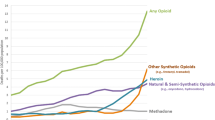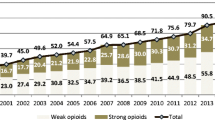Abstract
Purpose of Review
This study aimed to contribute to the debate on the availability of opioids for pain management by comparing regional and global trends for controlled strong opioids most commonly used for pain over the past 21 years. We conducted a series of analyses on the use of 12 opioids, with a focus on fentanyl, hydrocodone, hydromorphone, morphine, and oxycodone over the 21-year period of 1995–2015, at a regional and global level with country-level data, using random intercept mixed models to assess for change over time and interactions, and controlling for country economic development.
Recent Findings
Despite the sufficient supply of opioids to cover global demand, potent opioid pain medications are not available in many regions of the world. Prices of basic off-patent opioid formulations are significantly higher in poor countries as compared to lowest global prices, whilst countries may be under pressure to acquire expensive formulations. This results in lower availability of opioids for pain management in lower-income countries.
Summary
The analysis shows that, when adjusted for country-level gross domestic product (GDP) per capita and Human Development Index (HDI) category, the most significant trends in opioid consumption for pain management are those of morphine and fentanyl. Whilst the trend for use of morphine has remained relatively stable, fentanyl use has risen sharply in the past 21 years, even in regions where the levels of overall opioid availability are inadequate or very inadequate. The trends vary according to different regions of the world.







Similar content being viewed by others
References
International Narcotics Control Board. Availability of internationally controlled drugs: ensuring adequate access for medical and scientific purposes. Indispensable, adequately provided and not unduly restricted. New York: United Nations; 2015.
Berterame S, Erthal J, Thomas J, Fellner S, Vosse B, Clare P, et al. Use of and barriers to access to opioid analgesics: a worldwide, regional, and national study. Lancet. 2016;387:1644–56.
United Nations Office on Drugs and Crime. Outcome document of the 2016 United Nations general assembly special session on the world drug problem. New York: United Nations; 2016.
Knaul FM, Farmer PE, Krakauer EL, de Lima L, Bhadelia A, Jiang Kwete X, et al. Alleviating the access abyss in palliative care and pain relief—an imperative of universal health coverage: the lancet commission report. Lancet. 2018;391:1391–454.
Pastrana T, Wenk R, Radbruch L, Ebtesam A, De Lima L. Pain treatment continues to be inaccessible for many patients around the globe: second phase of opioid Price watch, a cross-sectional study to monitor the prices of opioids. J Palliat Med. 2016, 20(4).
Gisev N, Larance B, Cama E, Nielsen S, Roxburgh A, Bruno R, et al. A nationwide study of the extent and factors associated with fentanyl use in Australia. Res Soc Adm Pharm. 2018 Mar;14(3):303–8.
De Lima L, Pastrana T, Radbruch L, Wenk R. Cross-sectional pilot study to monitor the availability, dispensed prices, and affordability of opioids around the globe. J Pain Symptom Manag. 2014;48(4):649–59.
McPherson ML. Demystifying opioid conversion calculations. Bethesda: ASHP; 2010.
International Narcotics Control Board. Narcotic drugs 2008: estimated world requirements for 2009—statistics for 2007. New York: United Nations; 2008.
International Narcotics Control Board. Narcotic drugs 2016: estimated world requirements for 2017—statistics for 2015. New York: United Nations; 2016.
Author information
Authors and Affiliations
Corresponding author
Ethics declarations
Conflict of Interest
The authors declare that they have no conflicts of interest.
Human and Animal Rights and Informed Consent
This article does not contain any studies with human or animal subjects performed by any of the authors.
Disclaimer
The views expressed herein are those of the authors and do not necessarily reflect the views of the United Nations.
Additional information
Publisher’s Note
Springer Nature remains neutral with regard to jurisdictional claims in published maps and institutional affiliations.
This article is part of the Topical Collection on Opioids
Electronic Supplementary Material
Supplementary Figure S1
Trends from 1995 to 2015 in use of five most common opioid analgesics—fentanyl, hydrocodone, oxycodone, morphine, and hydromorphone, adjusted for country-level GDP per capita and HDI category, and taking into account inefficiency in fentanyl patches (DOCX 18 kb)
Rights and permissions
About this article
Cite this article
Erthal, J., Berterame, S., Clare, P. et al. Hot Topic: Global Trends in the Use of Opioid Analgesics. Curr Addict Rep 6, 41–48 (2019). https://doi.org/10.1007/s40429-019-0234-2
Published:
Issue Date:
DOI: https://doi.org/10.1007/s40429-019-0234-2




